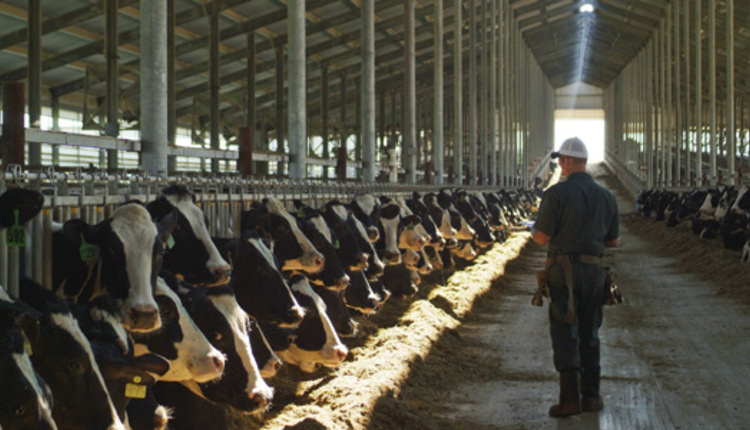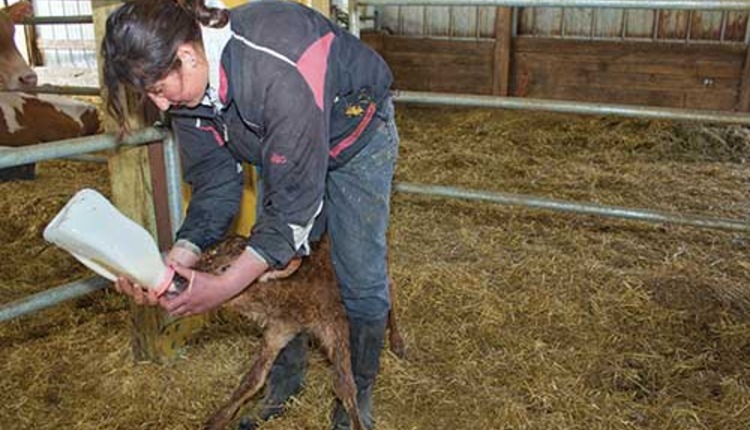Höglund is CEO of the Livestock Trust Institute in Raleigh, N.C. Beaver is a board certified veterinary behaviorist and a professor of veterinary medicine at Texas A&M University.
Consumers are continually demanding assurances in the humane treatment of farm animals and are mostly concerned with human and animal interactions. Responses to the demand for greater openness in livestock handling practices have spawned an array of new initiatives from dairy cooperatives, buyers and retailers that focus on promoting animal welfare in their supply chain.
Some industry players implement these programs to grow market share, positioning themselves as having addressed consumer concerns, but for most it is simply risk mitigation. They are seeking a degree of assurance that they won't end up on national news as the unwitting purchaser of product from the latest bad actor. Milk buyers tend to get what they want, and in response most milk processors are either imposing or exploring some form of welfare assessments or audits.
Finding ways to improve
Assessment and audit tools can be used by producers to identify problem areas and improve the welfare of their animals. They also are used to assure consumers that food is produced humanely. A distinction must be made between audit tools, intended to provide external validation that a farm meets specific standards, and assessment tools, with their greater emphasis on producer education and awareness.
Most assessment and audit tools include both animal based indicators of welfare (such as rates of injury, morbidity, mortality, body condition and reactivity to humans) and resource-based indicators (such as stall design, bunk space and number of watering troughs).
A useful audit/assessment tool is one that, if implemented effectively, yields highly repeatable results and identifies opportunities for improvement. Unfortunately, when primary assessment program objectives and language are not founded in science, long-term consequences can be devastating. "Folk-psychology" is at the heart of this quandary.
One of the first legitimate tools employed in dairy product image marketing is to promote humane handling of animals in agriculture. Showing the consumer good dairy farming practices is admirable and smart. Falsifying farming practices with exaggerations, pseudoscience and misleading illusions of knowledge are not. One of the most egregious examples of such misleading information is the so-called promotion of happy, friendly, playful and comfortable cows.
Do cows feel comfort?
Cow comfort is an extrapolation of the human feeling of comfort to describe what dairy cattle might be experiencing. Folk-psychologists attempt to explain what animals are thinking and feeling merely by watching the cow operate in her environment. Anthropomorphism is used to support such explanations.
As Carl Sagan is reported to have said about beliefs: "You can't convince a believer of anything; for their belief is not based on evidence; it is based on their deep-seated need to believe." The number one rule in human and animal interactions is to quit trying to explain the animal's behavior in terms of what it might be thinking or feeling.
So, what is "cow comfort"? Few authors define it. One of the initial uses of the term indicated that cow comfort represented "lying" behavior in dairy cows. That definition has been expanded from lying behavior to include many other observable in-barn behaviors, including perching, walking, restlessness and caudal licking. Some just use the words "cow comfort" as if comfort is a fact of life in dairy cattle.
The "comfortable cow" promotion is a passionate argument to make farming appear humane. It doesn't take much thought to realize, however, that things might not be all that they seem.
As an example, the cow must be comfortable lying on a water bed because a person would be. But add to that the possibility that lame cows will lie down for longer periods and the cow may or may not really be comfortable. There is no validated way of knowing if the cow is comfortable.
The real-world problem with the "cow comfort" and "happy cow" logic is that consumers are intelligent, and they will come to recognize things are not as they seem. Deception through pseudoscience might work for awhile, but consumers are also asking what farmers are doing to actually be humane, safe and efficient.
To put this discussion into a broader context for the entire animal agriculture industry, it is important to project this a few years into the future. If cattle can have human motivations, they could have all the rights of humans, and no one would be able to own them.
Activists talk about animal rights, but in the end they are seeking the abolition of private property ownership of animals in agriculture. Worse yet, animal activists might even use "cow comfort" pseudoscience to convince legislators or judges that cows are "people" in the legal sense. And you can't own people.
Animal welfare and well-being can be measurable, nonsubjective, clinical terms that should be used instead of words like "happy" and "friendly." Comfort and feelings of happiness are scientifically unknowable in animals.
Promoting these concepts is potentially dangerous to the consumer's perception of where dairy foods come from and, ultimately, to private property ownership of cattle. If we keep assigning human feelings to cattle that are not supported by science, we might be able to study how quickly we lose private property ownership of them.
The "cow comfort" traps
Below are eight reasons why promoting ambiguous, unknowable cow feelings could be dangerous to farmers:
Click here to return to the Animal Care E-Sources
1511_735
Consumers are continually demanding assurances in the humane treatment of farm animals and are mostly concerned with human and animal interactions. Responses to the demand for greater openness in livestock handling practices have spawned an array of new initiatives from dairy cooperatives, buyers and retailers that focus on promoting animal welfare in their supply chain.
Some industry players implement these programs to grow market share, positioning themselves as having addressed consumer concerns, but for most it is simply risk mitigation. They are seeking a degree of assurance that they won't end up on national news as the unwitting purchaser of product from the latest bad actor. Milk buyers tend to get what they want, and in response most milk processors are either imposing or exploring some form of welfare assessments or audits.
Finding ways to improve
Assessment and audit tools can be used by producers to identify problem areas and improve the welfare of their animals. They also are used to assure consumers that food is produced humanely. A distinction must be made between audit tools, intended to provide external validation that a farm meets specific standards, and assessment tools, with their greater emphasis on producer education and awareness.
Most assessment and audit tools include both animal based indicators of welfare (such as rates of injury, morbidity, mortality, body condition and reactivity to humans) and resource-based indicators (such as stall design, bunk space and number of watering troughs).
A useful audit/assessment tool is one that, if implemented effectively, yields highly repeatable results and identifies opportunities for improvement. Unfortunately, when primary assessment program objectives and language are not founded in science, long-term consequences can be devastating. "Folk-psychology" is at the heart of this quandary.
One of the first legitimate tools employed in dairy product image marketing is to promote humane handling of animals in agriculture. Showing the consumer good dairy farming practices is admirable and smart. Falsifying farming practices with exaggerations, pseudoscience and misleading illusions of knowledge are not. One of the most egregious examples of such misleading information is the so-called promotion of happy, friendly, playful and comfortable cows.
Do cows feel comfort?
Cow comfort is an extrapolation of the human feeling of comfort to describe what dairy cattle might be experiencing. Folk-psychologists attempt to explain what animals are thinking and feeling merely by watching the cow operate in her environment. Anthropomorphism is used to support such explanations.
As Carl Sagan is reported to have said about beliefs: "You can't convince a believer of anything; for their belief is not based on evidence; it is based on their deep-seated need to believe." The number one rule in human and animal interactions is to quit trying to explain the animal's behavior in terms of what it might be thinking or feeling.
So, what is "cow comfort"? Few authors define it. One of the initial uses of the term indicated that cow comfort represented "lying" behavior in dairy cows. That definition has been expanded from lying behavior to include many other observable in-barn behaviors, including perching, walking, restlessness and caudal licking. Some just use the words "cow comfort" as if comfort is a fact of life in dairy cattle.
The "comfortable cow" promotion is a passionate argument to make farming appear humane. It doesn't take much thought to realize, however, that things might not be all that they seem.
As an example, the cow must be comfortable lying on a water bed because a person would be. But add to that the possibility that lame cows will lie down for longer periods and the cow may or may not really be comfortable. There is no validated way of knowing if the cow is comfortable.
The real-world problem with the "cow comfort" and "happy cow" logic is that consumers are intelligent, and they will come to recognize things are not as they seem. Deception through pseudoscience might work for awhile, but consumers are also asking what farmers are doing to actually be humane, safe and efficient.
To put this discussion into a broader context for the entire animal agriculture industry, it is important to project this a few years into the future. If cattle can have human motivations, they could have all the rights of humans, and no one would be able to own them.
Activists talk about animal rights, but in the end they are seeking the abolition of private property ownership of animals in agriculture. Worse yet, animal activists might even use "cow comfort" pseudoscience to convince legislators or judges that cows are "people" in the legal sense. And you can't own people.
Animal welfare and well-being can be measurable, nonsubjective, clinical terms that should be used instead of words like "happy" and "friendly." Comfort and feelings of happiness are scientifically unknowable in animals.
Promoting these concepts is potentially dangerous to the consumer's perception of where dairy foods come from and, ultimately, to private property ownership of cattle. If we keep assigning human feelings to cattle that are not supported by science, we might be able to study how quickly we lose private property ownership of them.
The "cow comfort" traps
Below are eight reasons why promoting ambiguous, unknowable cow feelings could be dangerous to farmers:
- "Cow comfort" serves as an example to reveal the peril of using an ambiguous, everyday term about a human experience in terms of what cattle could experience.
- The gold standard for knowing if feelings exist is verbal self-reporting. Cattle are not able to self-report via language.
- Scientists must explain what they are studying in terms of animal welfare and well-being, especially as it influences laws, contracts, oversight and "codes of practice."
- We have an obligation to tell the truth as we know it, not as we want it to be.
- The use of anthropomorphism could ultimately define private property ownership of animals.
- Making cows "human" risks their private property designation.
- Private property ownership is one of the main reasons that dairy farming is worth the effort.
- Good animal welfare and well-being includes health care, and it has measurable parameters.
1511_735










